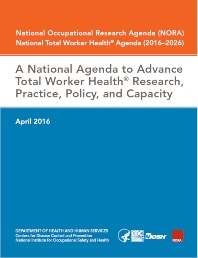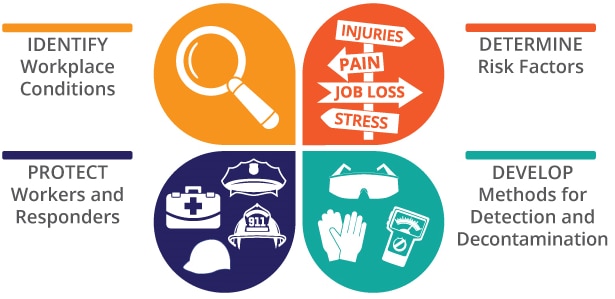Total Worker Health® Research Program
The NIOSH Office for Total Worker Health (TWH) works to advance the safety, health, and well-being of workers by increasing the number of work environments that adopt evidence-based TWH approaches. This is accomplished through both intramural and extramural research programs that effectively advance etiologic, surveillance, and intervention research. As a result, this builds the evidence base for an integrated, holistic approach to worker well-being.
The program has developed an overarching agenda for the nation to help coordinate and prioritize these efforts, the National Occupational Research Agenda/National Total Worker Health Agenda (2016-2026). However, research efforts also remain flexible to focus on emerging and fast-breaking threats facing todays’ workers, on the job and away from it.
Total Worker Health Agenda

The National Total Worker Health® Agenda (Agenda)is a National Occupational Research Agenda (NORA) intended to define and prioritize TWH related occupational safety and health research, practice, and prevention activities for 2016-2026. This document is built on an earlier draft version entitled, Proposed National Total Worker Health Agenda, released in September 2014 for stakeholder comment. The resulting input, documented in NIOSH’s Response to Summarized Stakeholder Commentspdf icon, shaped the continued direction and evolution of the TWH program at NIOSH as a whole.
NIOSH Future of Work Initiative

In May 2019, NIOSH launched the NIOSH Future of Work (FOW) Initiative. The initiative developed in response to the rapidly changing nature of workplace and work issues experienced by today and tomorrow’s workforce. Forces such as technological innovations, digital transformation, and globalization have an impact on workers and organizations in the United States and around the world. These new realities drive NIOSH-wide efforts to examine the FOW and broaden the approach to worker safety, health, and well-being.
As part of this collaborative initiative, the Institute is framing FOW based on the multidisciplinary TWH approach. Using the TWH framework, the initiative promotes worker well-being by encouraging collaboration across the spectrum of organizational policies, programs, and practices that influence the safety and health of workers, their families, communities, employers, and society.
Opioid Crisis Response

NIOSH uses TWH principles to develop solutions for workers and employers facing the opioid use epidemic in their communities. Visit the NIOSH Opioids in the Workplace webpage for workplace resources and to learn about ways NIOSH is addressing the opioids crisis.
To find out how NIOSH-funded grantees and other partners are working to address the opioid crisis visit Opioids in the Workplace: NIOSH Extramural Research.
Intramural Research
NIOSH sponsors intramural research through the NIOSH Program Portfolio. Intramural research on TWH approaches is coordinated through the Research Program Development & Collaboration Team (Research Program) in the NIOSH Office for TWH. Select examples include:
- TWH for Small Businesses
- Fatigue Prevention Training Program for Commercial Pilots in Alaska
- Promising Practices for Healthy Aging in the Workplace
NIOSH Healthy Work Design and Well-Being (HWD) Program Connection
By recognizing the critical role that well-being plays in NIOSH intramural research, the TWH program has had a widespread impact on other NIOSH programs. The programmatic blend of elements of three independent programs (TWH, Economic Research and Support Office, and Work Organization and Stress-related Disorders) is evident in the Healthy Work Design and Well-Being (HWD) Program. HWD is one of seven NORA cross-sector programs in the third decade of NORA.
The mission of the HWD program is to protect and advance worker safety, health, and well-being by improving the design of work, management practices, and the physical and psychosocial work environment. The holistic perspective of HWD focuses on how work affects overall health and well-being, including physical, psychological, social, and economic aspects.
Extramural Research
Centers of Excellence for Total Worker Health
NIOSH funds ten Centers of Excellence, located throughout the U.S., to explore and research TWH concepts. The centers develop and evaluate interventions designed to improve safety, health, and well-being in high-risk industries that can reduce healthcare costs when adopted on a broad scale. The Centers enable translation from research to practice, testing the process and feasibility of applying TWH approaches in real-world environments.
Listed below are some of the many ways that the Centers engage in TWH activities:
- Pilot test promising workplace policies and programs
- Develop and distribute best practices and tool kits
- Create strategies to overcome barriers for adoption of work-based interventions to protect and promote health
- Investigate costs and benefits associated with integrated programs
- Promote increased development and application of biological markers of stress, sleep, and depression to protect workers and improve worker health
- Examine the relationships between workplace policies and practices and worker health outcomes
For more information on the Centers of Excellence, please see the Office of Extramural Programs web page.
Total Worker Health Affiliates
The mission of the NIOSH TWH Affiliate Program is to foster an integrated approach to protecting and promoting worker well-being through collaborations with not-for-profit and government organizations, as well as academic and specialty member organization partners.
Related Resources
Priority Areas and Emerging Issues

